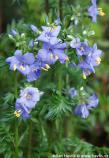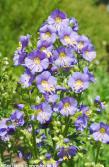Polemonium 'BRESSINGHAM PURPLE'

Polemonium 'BRESSINGHAM PURPLE'
Jacob's ladder
Jacob's ladder
| SIZE/TYPE | mid-sized perennial |
|---|---|
| USUAL HEIGHT | 0.3-0.4m |
| USUAL WIDTH | 0.3-0.4m |
| LEAVES | deciduous broadleaf |
| COLOUR OF LEAVES |
 + + multicoloured:green and burgundy red multicoloured:green and burgundy red |
| FLOWERS | showy |
| COLOUR OF FLOWERS |
 violet violet
|
| BLOOMING TIME | May - July |
| LOCATION | full to partial sun |
| SOIL TYPE | any (acidic to alkaline) |
| SOIL MOISTURE REQUIREMENTS | evenly moist (dislikes drought) |
| USDA zone (lowest) | 4 (down to -34°C) |
| WINTER PROTECTION | |
| FOR ZONE 5+6 |

|
| FOR ZONE 7 |

|
| BELONGS TO CATEGORIES | Perennials |
Jacob’ ladder is our native, Central European, hardy perennial which can be found also in Northern Europe, Northern Asia and North America. It belongs to the same family as phlox (Polemoniaceae) and its flowers offer a very nice shade of blue on medium-tall stems in early summer.
Bressingham Purple is a rather compact and profusely flowering variety of Jacob’ ladder with dark leaves. From late May or early June appear about 2 cm wide, 5-petalled flowers atop 30-40 cm tall fleshy stems. The flowers are purple-blue with striking yellow anthers. There are many of them and they open gradually (depending on the strength and age of the plant) for up to two months. The leaves are fern-like, pinnate, dark green with a deep maroon hues. They resemble yarrow leaves, which is perhaps why the plant is called Jacob's ladder in English and German, which according to the biblical story is supposed to lead to heaven. After flowering, we recommend removing the stems and the plant will form a neat clump of attractive leaves.
Jacob’ ladder is naturally found in moist, sometimes even wet meadows, but you can also find it in a sunny clearing, where at the peak of summer without enough rain it can lose above ground leaves and stems, becoming dormant in the ground until late summer. With good precipitation it is capable of making new leaves again in the same season, otherwise it will re-emerge in spring. In gardens, it is a maintenance-free perennial as long as you grow it in evenly moist and reasonably fertile soil. You can grow it in the sun or in partial shade, it will even bloom in the shade, but it will not be very compact there. It has no demands as to soil pH and does not weed around. Very hardy to approx. -34 °C and suitable for outdoor containers.
Last update: 26-05-2024
Bressingham Purple is a rather compact and profusely flowering variety of Jacob’ ladder with dark leaves. From late May or early June appear about 2 cm wide, 5-petalled flowers atop 30-40 cm tall fleshy stems. The flowers are purple-blue with striking yellow anthers. There are many of them and they open gradually (depending on the strength and age of the plant) for up to two months. The leaves are fern-like, pinnate, dark green with a deep maroon hues. They resemble yarrow leaves, which is perhaps why the plant is called Jacob's ladder in English and German, which according to the biblical story is supposed to lead to heaven. After flowering, we recommend removing the stems and the plant will form a neat clump of attractive leaves.
Jacob’ ladder is naturally found in moist, sometimes even wet meadows, but you can also find it in a sunny clearing, where at the peak of summer without enough rain it can lose above ground leaves and stems, becoming dormant in the ground until late summer. With good precipitation it is capable of making new leaves again in the same season, otherwise it will re-emerge in spring. In gardens, it is a maintenance-free perennial as long as you grow it in evenly moist and reasonably fertile soil. You can grow it in the sun or in partial shade, it will even bloom in the shade, but it will not be very compact there. It has no demands as to soil pH and does not weed around. Very hardy to approx. -34 °C and suitable for outdoor containers.
Last update: 26-05-2024
SIZES and PRICES
GLOSSARY
|











